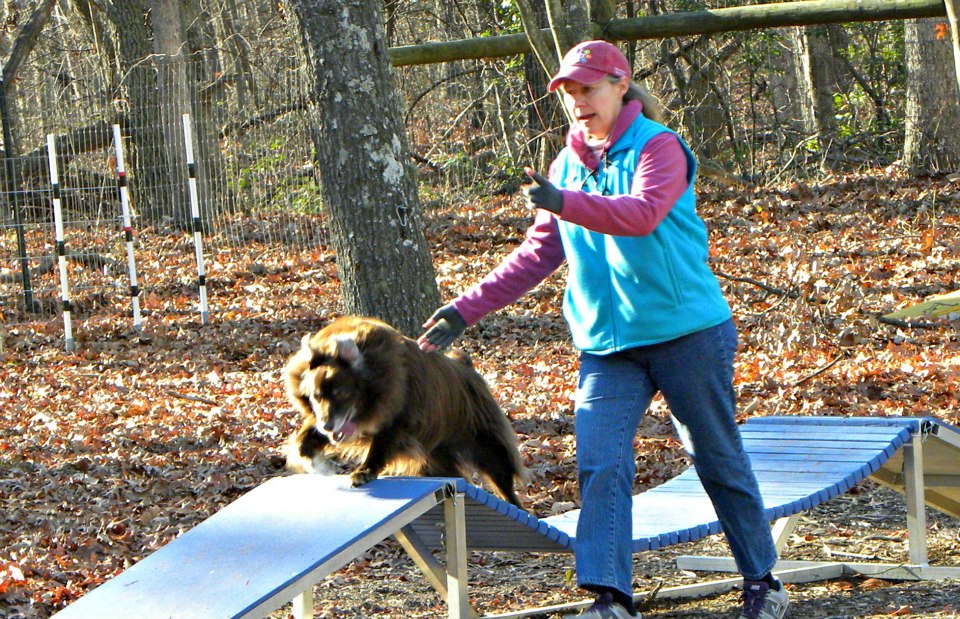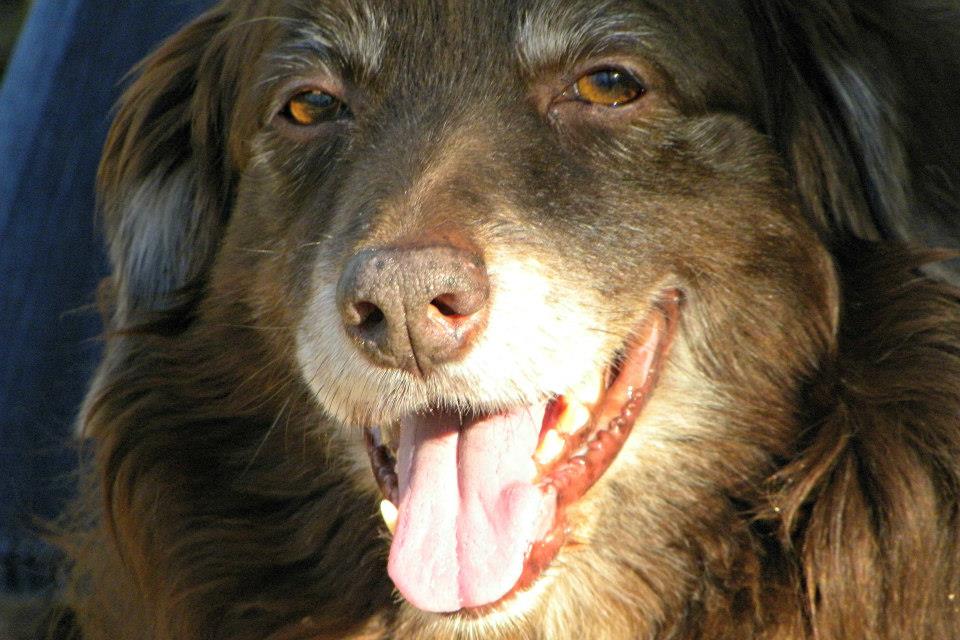“Keep going. Keep going.” Becky heard these words from me so many times over the last few months; she knew that something remarkable may happen if she just kept moving. Ruff missed a jump, and the Aframe but when he got to the weave poles he had his best run ever, got his entry, drove his way through and didn’t miss a pole. Awesome! We didn’t care about missing the jump or the Aframe because Ruff was not here preparing for competition, he was here preparing for life.
Ruff is an Australian Shepard who lunged and barked at everything that moved. My first meeting with Ruff was ... well, rough. Jim and Becky had an elaborate routine to keep visitors safe. It involved ignoring and restraining Ruff until he was calm then feeding him apples. Knowing this was not going to get me very far, I fed him beef. He liked it, but I soon learned no amount of red meat was going to let me touch him. Ruff’s world changed that day. Ruff had fear aggression and instead of playing into his fears we were going to start overcoming them.
The first part of the strategy was to take Ruff out of his comfort zone and challenge him. We began simply by putting his pillow in a different corner, moving his water bowl and feeding him in a different room in the house. I showed Jim and Becky how to stand calmly at the side of the road when people and cars passed during their walks. The more scary stuff he could experience, the more fears he could overcome. Part two was to teach Jim and Becky not to reinforce his fear. For example, Ruff did not like storms. Unknowingly Ruff’s fear of thunder and lightning was being fed by Jimmmy and Becky’s fear of what Ruff was going to do. Instead of trying to calm him, they leave him access to his favorite spot and let him deal with the storm on his own. Finally, the third part of Ruff’s renewal was agility.
When I teach agility to reactive or fearful dogs I always start with the table. While on the table they hang outwith their handler eating treats, playing tug or receiving rubs and praise for as long as necessary. The table is the place where handlers can regain control of their dogs and dogs can regain control of themselves. I want the table be the dog’s favorite spot on the field. Out of control dogs that are consistently sent to the table will eventually go there on their own.This behavior is the beginning to self control which is the most important skill reactive and fearful dogs need on and off the agility field.
Once we established a safe place for Ruff, we got him moving; on, through and over the agility equipment. In recreational agility training we are not as concerned with accuracy as we are with activity. The more obstacles we can overcome the better. Ruff was quick to conquer the contact equipment, always starting and ending on the table. He immediately went through a drum which is the collapsed tunnel without the chute, dogs love them. I see a lot of reactive dogs that are afraid of a tunnel at any length, so I put two or three drums in a row and narrow the gap between them until it becomes a tunnel. Then the tunnel is introduced without fear.
It was Becky’s job to keep Ruff going forward, even if he missed an obstacle. This was an important lesson when it came to jumping. Ruff did not like to jump, so we put a jump between his two favorite obstacles, the drum and the table. Becky did not stop if he missed the jump, but she limited her praise on table. Ruff learned that his time on the table was more rewarding when he did the jump so jumping soon became as much fun as the table and the drum.
Ruff is much better now. At home, Ruff has a place he goes and controls himself so visitors can safely go in and out of the house. Jimmy and Becky can also take him on a walk without fear of him barking and lunging. They can stop and talk to neighbors while Ruff lies down at their feet. He is moving forward to overcome obstacles whether it is a storm outside or a jump on the agility field. Ruff will never compete in agility, but agility has changed his life in ways that cannot be measured by ribbons and titles. “Keep going Ruff, you are awesome!”
Ruff is an Australian Shepard who lunged and barked at everything that moved. My first meeting with Ruff was ... well, rough. Jim and Becky had an elaborate routine to keep visitors safe. It involved ignoring and restraining Ruff until he was calm then feeding him apples. Knowing this was not going to get me very far, I fed him beef. He liked it, but I soon learned no amount of red meat was going to let me touch him. Ruff’s world changed that day. Ruff had fear aggression and instead of playing into his fears we were going to start overcoming them.
The first part of the strategy was to take Ruff out of his comfort zone and challenge him. We began simply by putting his pillow in a different corner, moving his water bowl and feeding him in a different room in the house. I showed Jim and Becky how to stand calmly at the side of the road when people and cars passed during their walks. The more scary stuff he could experience, the more fears he could overcome. Part two was to teach Jim and Becky not to reinforce his fear. For example, Ruff did not like storms. Unknowingly Ruff’s fear of thunder and lightning was being fed by Jimmmy and Becky’s fear of what Ruff was going to do. Instead of trying to calm him, they leave him access to his favorite spot and let him deal with the storm on his own. Finally, the third part of Ruff’s renewal was agility.
When I teach agility to reactive or fearful dogs I always start with the table. While on the table they hang outwith their handler eating treats, playing tug or receiving rubs and praise for as long as necessary. The table is the place where handlers can regain control of their dogs and dogs can regain control of themselves. I want the table be the dog’s favorite spot on the field. Out of control dogs that are consistently sent to the table will eventually go there on their own.This behavior is the beginning to self control which is the most important skill reactive and fearful dogs need on and off the agility field.
Once we established a safe place for Ruff, we got him moving; on, through and over the agility equipment. In recreational agility training we are not as concerned with accuracy as we are with activity. The more obstacles we can overcome the better. Ruff was quick to conquer the contact equipment, always starting and ending on the table. He immediately went through a drum which is the collapsed tunnel without the chute, dogs love them. I see a lot of reactive dogs that are afraid of a tunnel at any length, so I put two or three drums in a row and narrow the gap between them until it becomes a tunnel. Then the tunnel is introduced without fear.
It was Becky’s job to keep Ruff going forward, even if he missed an obstacle. This was an important lesson when it came to jumping. Ruff did not like to jump, so we put a jump between his two favorite obstacles, the drum and the table. Becky did not stop if he missed the jump, but she limited her praise on table. Ruff learned that his time on the table was more rewarding when he did the jump so jumping soon became as much fun as the table and the drum.
Ruff is much better now. At home, Ruff has a place he goes and controls himself so visitors can safely go in and out of the house. Jimmy and Becky can also take him on a walk without fear of him barking and lunging. They can stop and talk to neighbors while Ruff lies down at their feet. He is moving forward to overcome obstacles whether it is a storm outside or a jump on the agility field. Ruff will never compete in agility, but agility has changed his life in ways that cannot be measured by ribbons and titles. “Keep going Ruff, you are awesome!”


 RSS Feed
RSS Feed